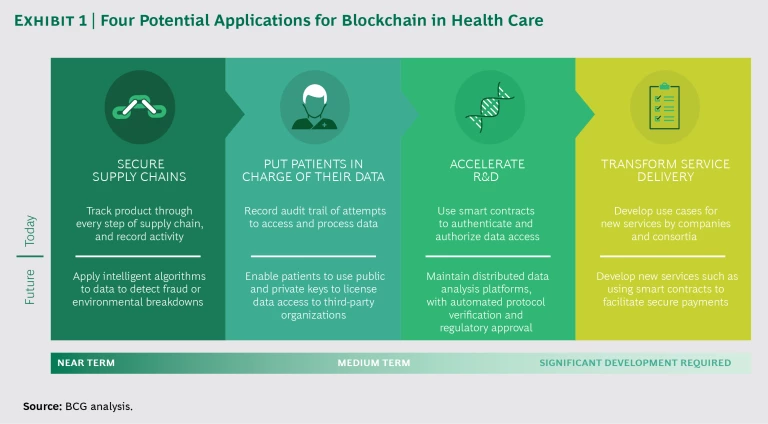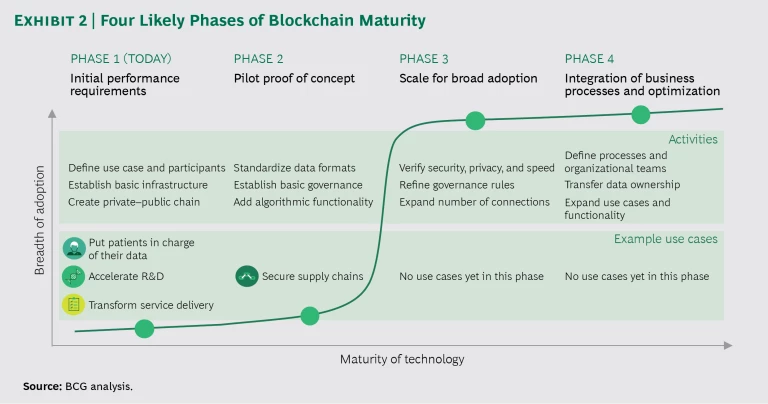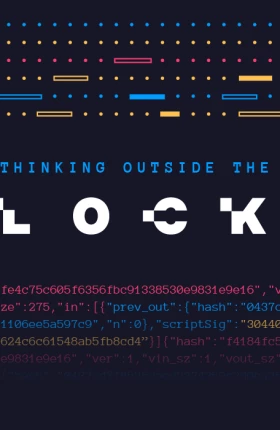Among the industries in which expectations for blockchain technology run high, health care holds a leading position. And there are a number of good reasons for its prominence. Health care is complex and data intensive. The industry has lots of players. Currently, health care transactions are slow, cumbersome, and expensive. Constraints on access to critical data sets limit progress in research. Data privacy is a big deal. Data security can be a life-or-death matter.
Many industry experts and analysts point to blockchain—the technology that underlies Bitcoin and other cryptocurrencies—as a possible solution for some of the biggest issues that health care faces. They predict powerful new capabilities and a potentially massive disruption of current approaches to services, care, and accountability. Blockchain’s potential to speed up and improve R&D, care delivery, and care management, and to reduce costs, they say, is enormous. They may be right, but the road to nowhere is paved with unfulfilled potential, so it pays to be cautious.
A blockchain is a distributed online ledger that can prove whether a piece of data is authentic. Every owner of a Bitcoin—the most widely used commercial application of blockchain so far—can see the history of that particular coin, including where and how it has been spent (although not the identities of its previous owners), to confirm that it is not counterfeit. This online ledger is publicly accessible to anyone on the internet, and no single version exists for a hacker to corrupt. Blockchain thus has the potential to change how we store and share confidential data and how we conduct all manner of transactions, by eliminating agents, brokers, traders, and other intermediaries.
Several of our colleagues have outlined how blockchain can reshape the economics of transaction costs and trust. (See “ Thinking Outside the Blocks ,” BCG essay, December 2016.) Our colleagues did not try to prescribe what companies should do; instead, they offered a strategic context to help executives frame the right questions to ask. Our goal in this article is to bring a similar perspective to the potential for blockchain in health care.
Four High-Impact Scenarios
The same attributes that enable secure, validated, anonymous, and efficient financial transactions with cryptocurrencies—and disintermediate such middlemen as banks and brokers—can be applied to transactions in other data-intensive, highly regulated, and inefficient industries such as health care. All health care applications today are still in early stages of development and proof of concept—but let’s consider four promising health-care-related scenarios. (See Exhibit 1.)
Securing Supply Chains. Because transactions using blockchain are recorded on a chronological, validated (by an audit trail), and unalterable ledger, blockchain can completely remake supply chains across the health care sector. One major potential application—already in use in other industries such as grocery, luxury goods, and shipping—involves having pharma and medtech companies track the journey of raw materials, compounds, or components through every step of the supply chain, from the source to company facilities to the consumer or patient. The supplier can log information onto a blockchain ledger by direct data entry or by data transfer from sensors connected to the Internet of Things (IoT). Since information on a blockchain is both accessible (to those with permission) and unchangeable, blockchain owners can identify counterfeit materials, malfunctions, or environmental breakdowns, and can validate that materials or components have not been tampered with or subjected to adverse environmental conditions—thus confirming a tamper-free cold chain, for example.
Companies in health care and other industries are developing such solutions. The MediLedger Project, backed by a group of companies that includes pharma giants Genentech and Pfizer, has successfully piloted a program that uses blockchain tools provided by Chronicled, a US-based startup, to track medicines. Modum.io combines sensors and blockchain technology to monitor products requiring cold-chain handling to improve pharma supply-chain efficiency. BlockVerify authenticates products by tracking QR codes on packaging on a blockchain (for pharmaceuticals, precious stones, electronics, and luxury items).
Putting Patients in Charge of Their Data. Blockchain can help put patients in charge of their data, and it can enable physicians at different institutions (that have been granted permission) to access that data for better diagnoses and medical interventions. Today it is technologically possible to record all medical data transactions on a blockchain record, which could enable patients to maintain a complete audit trail of every doctor, provider, payer, medical device, health information exchange (HIE), or other person or entity that has had access to their data. In addition to the obvious diagnosis- and treatment-related benefits of ready access, such full transparency helps build trust between patients and other participants in the health care system. It also avoids the potential privacy and ethical dilemmas that may arise when patients inadvertently share, or companies gain access to, more data than is desired or intended.
One company exploring blockchain’s potential with respect to patient data, Google’s DeepMind, is working with Britain’s National Health Service (NHS) to deploy a private blockchain (a blockchain distributed within a closed network of participants) to create robust audit trails that track exactly what happens to personal data. The goal is to enable the NHS—and eventually patients—to track personal data access and use in real time.
MIT Media Lab has developed MedRec, which it describes as “a novel, decentralized record management system for EMRs that uses blockchain technology to manage authentication, confidentiality, accountability, and data sharing.”
Accelerating R&D. Blockchain has the potential to streamline and accelerate R&D, boosting innovation and lowering costs at pharma and medtech companies. For example, it can automatically validate, coordinate, and maintain consistent adherence to approved trial protocols across R&D projects and sites. Patients can self-identify and enroll in clinical trials, and the system will automatically assess and verify their eligibility. Researchers can quickly gather needed clinical data in reliably verified ways, as the system stores all data in a consistent, accessible infrastructure in which patients grant access to others by sharing public and private keys. Richer data sets will enable more complex studies and robust results. Smart contracts (lines of code executed in certain circumstances) can monitor data continuously mined from health records to identify appropriate new trials or to prevent complications.
All of this means faster, more cost-efficient completion of trials through more efficient patient recruitment, sharing of data across multiple sites, decreased preprocessing of data, and faster regulatory approvals. With better information available earlier in the process, companies can end trials when success appears unlikely and shift resources to higher-potential endeavors.
Academic institutions and pharma companies are exploring ways to realize this potential. For example, researchers at MIT are developing the OPAL/Enigma platform, which enables parties to jointly store and analyze data with complete privacy.
Transforming Service Delivery. Blockchain can enable entirely new delivery models that speed up services, reduce costs, and potentially disrupt long-standing procedures. One possibility is a prescription drug exchange—a patient-driven prescription fulfillment system independent of any one pharmacy or pharmacy benefit manager. Such a model would lower the cost of prescriptions by opening market competition to small and new large players, removing barriers to entry, and streamlining how companies comply with formula regulation. It might also improve access to prescription drugs, while maintaining patient confidentiality and a secure marketplace.
Although we know of no concrete examples of this kind of activity yet, the history of other industries and recent moves by new-to-health-care players such as Amazon (which provides blockchain services through its Amazon Web Services platform) suggest that sooner or later these companies will wield their technological capabilities in disruptive ways in the health care industry.
From Evolution to Revolution?
Blockchain will not disrupt health care overnight—or even over the next few years. Various aspects of funding, technology and talent, governance, and collaboration need to develop further before we reach a tipping point in adoption and impact. Even so, lots of players are aggressively pursuing solutions. As blockchain technology overcomes hurdles and continues to mature—moving from establishing initial performance requirements to building a pilot proof of concept to scaling up successful models, and ultimately to integrating those models into business processes—we expect adoption to increase. (See Exhibit 2.)
Funding. Venture capital firms and angel investors are actively investing at early stages in blockchain health care companies. In 2016, Gem, a California-based startup that focuses on blockchain solutions for health care (among other applications), received $7.6 million from Pelion Venture Partners, bringing Gem’s total funding raised since 2014 to $12.5 million.
New ventures continued to find backing in 2017. In March, PokitDok, raised $5 million from GIS Strategic Ventures and McKesson Ventures, bringing its total funding raised since 2012 to $50 million. In June, the blockchain-powered health informatics exchange Patientory raised $7.2 million from 1,728 investors in three days. And in September, Candor Insurance, a private health care exchange established to democratize health insurance through the use of blockchain, raised $3.0 million.
Compared with investments in artificial intelligence for health care, which totaled almost $800 million in 2016, the amounts invested in blockchain thus far are small. The pace of funding activity is accelerating, however. Philips launched a blockchain R&D facility in the Netherlands in 2016 and is seeking collaborators. Other large players such as IBM and Microsoft are bullish about incorporating blockchain platforms and development in their customer support systems. While much of the activity to date is based in the US and the UK, few barriers prevent others—including health care and technology entrepreneurs, funding partners, and corporate partners in other countries—from joining the party.
Technology and Talent. A 2017 article in the Harvard Business Review draws parallels between the development of TCP/IP—the technology behind the World Wide Web—and blockchain.
Among the technical challenges that remain are issues related to processing speed (blockchain ledgers must be able to handle large volumes of complex transactions at high speed), security, privacy (ensuring adequate levels of encryption for data stored on the distributed ledger), and breadth of capabilities (at the moment, blockchain skills are limited and concentrated in a few clusters around the world).
Perhaps most significant, in order to mature beyond proof of concept and deliver on their promise, actual applications must be built on scalable protocols. Finding the skills to build the right technology is a major challenge today. Competition for talent among companies working in multiple advanced technologies (such as artificial intelligence and machine learning) means that the supply of skills and expertise will remain a bottleneck for the foreseeable future. Over time, however, technology-related issues are likely to be less of a barrier to blockchain’s broader application than governance and collaboration.
Governance. Any potentially transformative technology raises complex questions about governance, which will require significant effort to resolve. Even basic questions must be addressed. For example, what are the responsibilities and rights of individual participants in blockchain ecosystems? What should be done when something goes wrong?
Cryptocurrencies remain largely unregulated and operate under the paradigm of “Code is law,” meaning that little or no regulation governs the technology or its use. A company called Dfinity has developed a next-generation decentralized decision-making system, the Blockchain Nervous System, which it says can act as a “benevolent decentralized superuser that can solve problems otherwise intractable without human intermediaries.” In this paradigm, “AI is law.”
Before patients, providers, and others feel entirely comfortable handing over personal data to a blockchain, we expect that laws and regulations—including laws governing blockchain’s smart contracts, procedures for data sharing, and reporting of financial transactions—will have to supersede technological self-enforcement. Many tricky issues remain unsolved. For example, if patients control their own data, how do we ensure that health care services have access to sufficient information in emergency situations, such as when a patient is unconscious or otherwise incapacitated? Under many legal provisions governing data privacy (such as Europe’s General Data Protection Regulation), a consumer has the right to insist on the erasure of certain data. How does this right apply to an immutable ledger?
Collaboration. Because blockchain’s power lies in simplifying, speeding, and lowering the cost of transactions, its effectiveness depends on the willingness of multiple parties to participate in blockchain-enabled systems or networks. Realizing the full benefits of such a system requires cooperation among entities across the health care industry, which is difficult to achieve. There is positive activity in that direction, however.
Hyperledger, an open-source collaborative effort hosted by the Linux Foundation to advance cross-industry blockchain technologies, has established the Hyperledger Healthcare Working Group. Hashed Health, another consortium of health care companies, offers its members product development and management services to support blockchain solutions and networks.
There are also significant barriers to collaboration. Achieving blockchain’s full potential in health care requires the adoption of common data definitions, an issue that has bedeviled the industry for years. Similarly, the implementation and enforcement of smart contracts will require coordination and agreement among multiple participants. As in other industries, participants must decide whether the prospective gains in growth and efficiency outweigh the risk of being at least partially commoditized by a new, dominant transaction platform; and if not, whether they can act in concert (as banks are attempting to do) to protect their autonomy.
Collaboration is already proving to be a stumbling block to wider use of blockchain in financial services. Private (or permissioned) blockchains offer one potential solution to many issues involving collaboration, but they come with tradeoffs, such as the ability of other participants to connect to the network and the security that only a large number of participants can provide. (With smaller networks, the computer power needed to disrupt the blockchain networks decreases, increasing the system’s vulnerability to an attack.) In addition, like companies, consortia struggle to recruit core talent in an environment where people with the requisite knowledge and expertise are scarce.
What Should Health Care Companies Do Now?
No one knows how quickly blockchain will become integrated into health care or how big its impact will be. But evidence of potential use cases with substantial benefits is strong enough to justify confidence that the technology will eventually change current practices and models to some degree—and perhaps extensively. Clearly, companies throughout the sector need to prepare.
Right now, preparation means starting to engage with blockchain, considering potential uses and applications, and beginning to build initial capabilities. This will entail committing modest resources to developing internal skills, collaborating with others, and adopting a test-and-learn approach. The goal is to prepare the organization to move quickly and participate more actively (through internal initiatives, accelerators, external partners, or consortia, for example) when evidence emerges that blockchain is maturing.
The actual steps to take in preparation will vary by industry segment.
Pharma. Supply chains are among the business areas most likely to feel blockchain’s influence. Companies can realize significant value by ring-fencing supply chains from counterfeiters, validating product quality, improving operational efficiency, and accelerating R&D.
Companies can get up to speed on blockchain by identifying and sizing the value that blockchain can provide in improving supply chain operations and cutting costs. Companies should determine how best to acquire capabilities—whether to develop in-house technologies, acquire startups, or buy capabilities as a service, for example. They may also consider establishing incubators, accelerators, or internal or external innovation centers. (See “ Bringing Outside Innovation Inside ,” BCG article, January 2017.) Potential applications of blockchain to pharma supply chains and R&D are sufficiently advanced that companies can identify concrete use cases and start experimenting with off-the-shelf solutions as these become available. Alternatively, companies can enter into partnerships with startups to develop solutions for specific applications.
Medtech. For medtech companies, patient ownership of data can lead to new ways of interacting directly with patients and may open new markets. Being able to enter into contracts with patients about the exchange and use of data could help overcome constraints on innovation that HIPAA and other privacy regulations have imposed. Medtech developers will want to explore how they can use blockchain technology to secure data transactions among connected devices (especially remote devices such as pacemakers, insulin pumps, and sleep apnea equipment) and perhaps to establish broader ecosystems (patient, provider, medtech supplier) around connected devices.
Providers and Payers. Like any emerging technology, blockchain can present both an opportunity for and a threat to incumbents. If patients truly controlled their own data, the benefits of blockchain to providers and payers (as well as to patients) in terms of efficiency and improved service capabilities would be difficult to overstate. However, the industry would also be open to an unprecedented risk of disruption. Blockchain technology can accelerate exposure to potential disintermediation, lowering switching costs and making it easier for startup services to enter the market and challenge the dominance of established paradigms of care.
First, nontechnical barriers must be surmounted. These include legal and regulatory constraints (some countries do not permit assimilation of patient identity and data from multiple sources, for example) and the absence of industry and technical standards for assimilation and use of data. To maintain their competitive advantage in potential new paradigms, incumbent players need to understand how blockchain can augment their traditional strengths in areas such as medical management, member services, network management, and support functions.
Payers and providers are well positioned to shape change through advocacy, participation in cross-industry dialogue on technology governance issues, and encouragement of partners, such as analytics providers, to include blockchain-enabled privacy controls in their applications. Because they deliver actual care, providers occupy an especially influential place in the health care sector. For their part, payers, since they control payments, can mandate which new formats of service delivery they will support.
Both payers and providers are now actively funding and participating in ventures aimed at delivery of new services. One example is Gem, which reports that it is prototyping a global, blockchain-based patient identifier that could link hospital records and data from other sources, such as employee wellness programs and wearable health monitors. Insurance company consortia have also formed in China (initiated by the Shanghai Insurance Exchange) and Europe (the Blockchain Insurance Industry Initiative, or B3i) to test use cases collaboratively.
The actual path or paths that blockchain will take in health care remain to be seen. But like other advanced technologies, such as the IoT and AI, blockchain has extreme disruptive potential—so much so that no company can afford to neglect the learning curve. Once they approach the tipping point, digital technologies move fast and can overwhelm organizations that are unprepared. Throughout the industry, pharma and medtech companies, payers, and providers need to engage with blockchain technology, learn the ropes, and think through potential scenarios so they will be ready to play when fast-moving commercial applications approach the mainstream.














